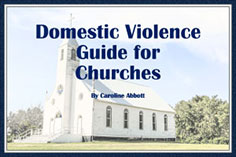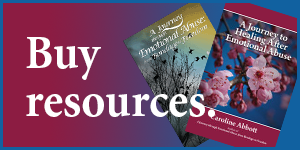It can be very painful to be a friend or family member of an abuse victim. Watching a friend go through abuse can make you feel frustrated and helpless. It may seem very obvious to you that your loved one should leave the abuser. You may wonder why she* won’t leave him, and may even try to make her do so.
Unfortunately, as you may have already discovered, you cannot force a person into a decision like this. Neither can you make an alcoholic decide to stop drinking, or an obese person go on a diet. Even if she leaves her abuser at your prompting, she may return to him.
So, what should a friend or family member do when someone they love is being abused by her partner? Doesn’t it make sense to tell her how you feel? Isn’t it right to explain that she shouldn’t allow someone to treat her this way? Doesn’t she need your help right now?
Yes, she does need your help, but not in the way you might think.  Tweet This
Tweet This
I am currently reading Changing for Good by Dr. James Prochaska et al.** This book has really opened my eyes to how people change and why they sometimes take so long to do so. These authors describe the six stages of change to be:
- Precontemplation – in this stage, the person does not even admit that they have a problem. They will minimize how bad their problem is in order to deny it exists, or they will rationalize their problem, giving excuses for the behavior of the abuser. If pushed, they may become very defensive. The best thing you can do for a person in this stage is to give them information about abuse, and to be available as a nonjudgmental friend.
- Contemplation – in this stage, the person is aware they have a problem, and is beginning to consider making some changes. They are not yet ready to act, but are thinking about it. If they leap into action at this stage, their action will most likely fail. In this stage, the person will really value a nonjudgmental friend. She will appreciate your empathy and care. Giving more information about abuse can also be helpful at this stage, provided you don’t push.
- Preparation – in this stage, the person realizes they have a problem, and is beginning to think of steps to change their situation. This might look like getting counseling, standing up to the abuser, reading books, calling a crisis center, or making a safety plan. This person still needs you to be their friend and give them moral support. Don’t be surprised if they suddenly stop moving forward and go back to one of the earlier stages. Making any kind of major life change is scary (think about losing weight or quitting smoking). But, leaving an abuser has even more fear attached to it because leaving is the most dangerous time for a victim.
- Action – in this stage, the person is finally ready to act. She may move out, get a restraining order, or begin seeking a divorce. Your friend may really need you now. Her life is suddenly completely new and chaotic. She may need a place to stay (be careful here – abusers can be dangerous), she may rethink her decision to leave a hundred times a day. Her children may be clambering at her to return home. The police and/or courts may be involved. This can be a real mess. Don’t desert her now!
- Maintenance – in this stage, the person evaluates all the changes in their life brought on by their action in the last stage. The chance of relapse is great. For an abuse victim, this probably looks like going back to their abuser, or beginning to see the abuser again. This is normal. Sadly, the average number of times a victim returns to the abuser is SEVEN! That means some return and leave again more than seven times. If your friend does this, try not to be judgmental. Help her know you still care and are there for her.
- Recycling – in this stage, the person learns from their former relapse(s). She may make adjustments to her plan. She may seek more outside help, like a support group to help her remain strong when the abuser tries yet again to get her to return. Continue being a strong, caring presence. Help her know you trust her to make the best decisions for her own life.
Here are some things you can do that might help your friend:
1. Try not to focus on how you are feeling. Yes, it is true that you may be feeling frustrated, helpless, and probably angry at her situation. She may be feeling all of these things as well. However, she probably has many other feelings, such as fear and confusion. She may be confused as to what is the best thing for her family, her mate, her children, and her future. She may love her abuser, and be unable to picture her life without him. She may be tied to him financially, and have a hard time envisioning life without his income. If she is married to her abuser, she may be afraid that God will be angry with her if she leaves him. She may be appropriately afraid of him, and realize that her life is in more danger if she leaves him than it is when they are together.
2. Educate yourself about abuse. There are many great ways to become more educated about domestic violence. Visiting websites such as this one is a good start. I recommend the National Domestic Violence Hotline website, (here is their link), and Jeff Crippen’s website, Unholy Charade, where he talks about spiritual abuse, (click here for the link).
You can also become trained as a domestic violence advocate. Local women’s shelters around the country often offer training for people from the community. Sometimes they require people to volunteer for their organization after the training, but not always.
3. Be supportive of your friend:
- Don’t judge her or her choices. Don’t bad-mouth her abuser. When you speak badly about him, she may feel like she needs to defend him to you.
- Don’t tell her what you think she should do; her abuser is already doing that. Instead, help her think through her options in a non-judgmental way.
- Don’t give her any ultimatums. If you say something like, “If you go back to him one more time, I wash my hands of you,” then she won’t be able to confide in you anymore. Even though she may not make the choices you would wish for her, or make changes in her life as quickly as you would like, she may still need your help at some time in the future. By resisting the urge to tell her what to do, you will remain a safe person for her to come to when she is ready.
Ecclesiastes 4:9,10,12 says:
Two are better than one, because they have a good return for their labor: If either of them falls down, one can help the other up. But pity anyone who falls and has no one to help them up…though one may be overpowered, two can defend themselves. A cord of three strands is not quickly broken.
Question: Have you ever tried to help a friend leave his/her abuser? What happened?
I pray this information will be a blessing to anyone who is trying to help a domestic violence victim.
May God bless you,
Caroline
Note: Abusers and victims can be either male or female.
James O. Prochaska, John C. Norcross & Carlo C. DiClemente, Changing for Good: A Revolutionary Six-Stage Program for Overcoming Bad Habits and Moving Your Life Positively Forward (New York: Quill Publlishers, 1994).



